Construction and Realization Path Analysis of Cross-Border E-Commerce Logistics Collaboration Model
Abstract
In order to improve the synergy effect of cross-border e-commerce slogistics, this paper combines intelligent logistics communication technology to construct a cross-border e-commerce collaborative logistics model. Moreover, this paper proposes a parallel energy-efficient routing algorithm based on 3D cell space to improve the system operation effect. In addition, this paper deeply analyzes the data fusion function performed by MA when accessing nodes and proposes a data fusion criterion to judge the necessity of data fusion on nodes. Finally, this paper balances the energy consumption of e-commerce logistics data fusion and data transmission so that the sum of the two is minimized. The data simulation analysis shows that the cross-border e-commerce logistics collaboration model proposed in this paper has certain effects, and it can be applied to the actual operation of cross-border e-commerce.
1. Introduction
Due to the globalization of the Internet, the scale of cross-border e-commerce transactions is increasing year by year. However, the transportation services of cross-border logistics are mainly provided by international logistics giants. Even if their logistics costs are high, they have always had a great advantage in the cross-border logistics market due to their advanced management level and service capabilities. Therefore, cross-border logistics has had a profound impact on the development of cross-border e-commerce. For cross-border e-commerce companies, if they want to stand out in the increasingly competitive market, they need to gain core competitive advantages. For now, it is far from enough to rely only on the low price advantage. When the external business environment of the company changes, this core competitiveness will be weakened, or it may face the threat of losing its advantage at any time.
The smooth development of various logistics links in the operation of cross-border logistics mode reflects the efficient operation of cross-border e-commerce logistics. However, the performance of its effective operation is not limited to this, and the rational choice of cross-border logistics operation mode also determines whether the enterprise can achieve the ultimate goal of sustainable development. Foreign experts and scholars have conducted an in-depth analysis of the relevant theories, advantages, and disadvantages of the current cross-border logistics mode in view of the development status of the cross-border logistics mode, and pointed out the future trend and direction of the development of the cross-border logistics mode. The research system objectively studies the theoretical basis and characteristics of the cross-border logistics model and proposes a feasible method for cross-border e-commerce enterprises to no longer completely manipulate the logistics business and change it to partial business outsourcing. This method effectively reduces the logistics cost significantly so that the enterprise can concentrate on the development of the core business. It is proposed that the development of the current logistics mode of cross-border e-commerce enterprises mainly includes four logistics operation modes: self-operated logistics mode, third-party logistics mode, logistics alliance mode, and logistics integration mode. With the gradual penetration of network technology in the operation of logistics business and the subdivision of the operational capabilities of each part of the logistics link, the fourth party logistics model is gradually developed on the basis of the development of these four logistics operation modes. Cross-border e-commerce enterprises should master the ability to efficiently process and integrate resources, and provide a complete and efficient supply chain development plan for the development of their logistics and other related links. However, for most of the current cross-border e-commerce enterprises, the applied logistics mode management solution has weak integration ability in supply chain. Therefore, the continuous and stable development of cross-border e-commerce enterprises is limited.
The smooth development of various logistics links in the operation of cross-border logistics mode reflects the efficient operation of cross-border e-commerce logistics, but its effective operation is not limited to this. The reasonable choice of cross-border logistics operation mode also determines whether an enterprise can achieve the ultimate goal of sustainable development. The research system objectively studies the theoretical basis and characteristics of the cross-border logistics model, and proposes a feasible method for cross-border e-commerce enterprises to no longer fully manipulate the logistics business and change part of the business outsourcing, which effectively reduces the logistics cost so that enterprises can concentrate on the development of core business [1]. It is proposed that the development of the current logistics mode of cross-border e-commerce enterprises mainly includes four logistics operation modes: self-operated logistics mode, third-party logistics mode, logistics alliance mode and logistics integration mode. With the gradual penetration of network technology in logistics business operation As well as the subdivision of the operation capabilities of each part of the logistics link, the fourth party logistics mode is gradually developed on the basis of the development of these four logistics operation modes [2]. Cross-border e-commerce enterprises should master the ability to efficiently process and integrate resources, and provide a complete and efficient supply chain development plan for the development of their logistics and other related links. However, for most of the current cross-border e-commerce enterprises, the applied logistics model management scheme has weak integration ability in the supply chain, thus restricting the sustainable and stable development of cross-border e-commerce enterprises [3].
Due to the uncoordinated development of the cross-border e-commerce industry and the cross-border logistics industry, the cross-border logistics model has encountered many problems in the development process. The study believes that in the context of cross-border e-commerce, although the cross-border logistics model can reduce the trade cost of traditional logistics, other trade costs due to language differences and cultural differences have also increased, and there are also significant returns and replacement costs increasing trend [4]. The research believes that the main factor affecting the development of cross-border e-commerce enterprises is the limitation of cross-border payment methods, which leads to the unfavorable development of cross-border logistics models [5]. From the perspective of the supply chain of the logistics model, it is found that the core enterprises have insufficient control, coordination, and integration of upstream and downstream enterprises, resulting in serious waste of resources, untimely goods circulation and low level of logistics services in the cross-border logistics supply chain, and other issues [6]. This paper discusses the current cross-border logistics mode and the types of enterprises that apply the cross-border logistics mode, and points out that the degree of coordination between cross-border e-commerce enterprises, customs, inspection and quarantine departments, and cross-border logistics enterprises is not high, resulting in low logistics efficiency [7].
Experts and scholars have put forward strategies and methods on how to improve the shortcomings of the cross-border logistics model from different perspectives and emphases. Aiming at the problems of long logistics distribution time, high logistics operation cost, and lagging development of cross-border logistics mode in cross-border logistics mode, it is proposed that enterprises should vigorously develop accounting informatization, and reduce logistics costs from effective financial management. And promote the construction of cross-border e-commerce logistics alliance to achieve effective integration and sharing of information [8]. The research believes that the logistics business operation process of cross-border e-commerce is relatively complicated, and the traditional cross-border logistics model cannot meet the economic growth of small and medium-sized enterprises. Therefore, it is urgent to transform and upgrade the current cross-border logistics model to adapt to a wider range of sexual market demand [9]. The research believes that when choosing a cross-border logistics mode, it is necessary to comprehensively analyze the advantages, disadvantages, and application scope of each logistics mode, and choose a more scientific cross-border logistics mode in combination with the actual operating conditions of the enterprise itself. The author pointed out that the choice of cross-border logistics mode should be analyzed from the characteristics of the main products of the enterprise, the scale and strength of its own development, the risk control ability of the enterprise, the service quality of the logistics mode, and the visualization of logistics information [10]. The study pointed out that if small and medium-sized cross-border e-commerce enterprises want to improve their comprehensive strength, they need to update and upgrade the applied cross-border logistics model in time. The author believes that the analysis should be made from the logistics market environment of the target country, the attributes of operating products, the cost of logistics operation costs, and the level of logistics service capabilities [11].
For the research on the choice of logistics mode, various experts and scholars have analyzed from the qualitative and quantitative perspectives. The following are the different analysis results of the experts and scholars. The research shows that different objects have different knowledge and understanding of each cross-border logistics mode, and there are many differences in the specific operation methods. The author mainly conducts a detailed study on the logistics business outsourcing mode, and points out that an integrated framework should be built to choose the logistics mode [12]. For the selection of cross-border e-commerce logistics mode, a logistics mode selection model combining logistics cost and logistics service quality is proposed [13]. The study believes that using modern information technologies such as the Internet of Things, big data, RFID, and cloud computing, a new model of international logistics based on supply chain can be created cross-border logistics cloud service, and the innovation of this model that is different from other logistics models is explained in detail. At the same time, the technical and operational characteristics of this logistics cloud service are proposed, which provides a new research direction for the innovation of logistics mode selection [14].
Although the development of cross-border e-commerce has brought unlimited business opportunities to the development of international logistics, international logistics is also an indescribable pain for cross-border e-commerce. Cross-border e-commerce and cross-border logistics lack synergy, and the development levels of the two do not match. From the current situation, it can be seen that only relying on international express delivery can no longer meet the needs of cross-border e-commerce logistics, and the cost is relatively high [15]. Traditional international logistics service providers were caught off guard when dealing with fragmented cross-border e-commerce logistics with small orders and large batches. The problem lies not only in the effective connection and improvement of international logistics hardware facilities but also in the integration of global logistics resource networks by international logistics service providers, whether it is for large logistics enterprises or cross-border e-commerce with self-built logistics systems, or for small and medium-sized logistics enterprises, they need to integrate themselves into the network layout of cross-border e-commerce logistics to maximize the utility with the smallest cost [16]. The combination of cross-border e-commerce and e-commerce brings challenges to traditional international trade clearance. The timeliness and rates of customs clearance for import and export are the first issues that cross-border import e-commerce merchants consider. On the basis of the traditional direct mail import channel and general goods import, the bonded customs clearance method of bonded stocking comes into being. This subverts the time and cost of customs clearance under the traditional method, and also means that cross-border e-commerce has more considerations and choices [17].
This paper combines the intelligent logistics communication technology to construct a cross-border e-commerce collaborative logistics model, analyzes its realization process, and improves the synergistic effect of cross-border e-commerce logistics.
2. Logistics Collaborative Communication Model
2.1. Routing Protocol
Directed diffusion is a data-centric data distribution protocol that uses attribute values to name data. Also, nodes request named data by sending “interest,” and the system sends data matching “interest” to the requesting node. Intermediate nodes can store data, transform data, and guide the delivery of “interest” based on data.
A simple directional diffusion diagram is shown in Figure 1, where 1(a) is the process of interest propagation: the central node initiates the interest and then spreads to the entire network. An interest entry is composed of a timestamp field, several gradient fields, and a duration field. After a node receives the interest, it will check whether there is the interest in its own interest buffer, if not, it will create the interest entry in the buffer, and if there is, update its timestamp field and duration field. 1(b) is the gradient establishment process, and a gradient represents a data rate and a propagation direction. 1(c) is the data sent from the source node to the destination node along the reinforcement path.

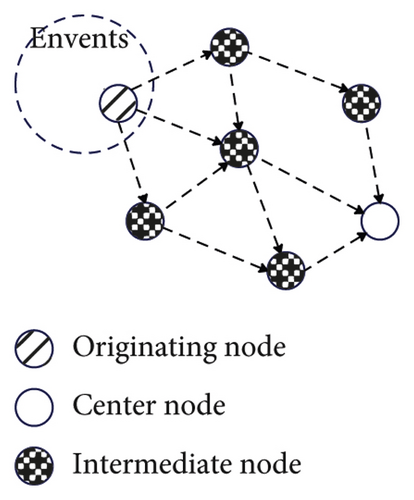
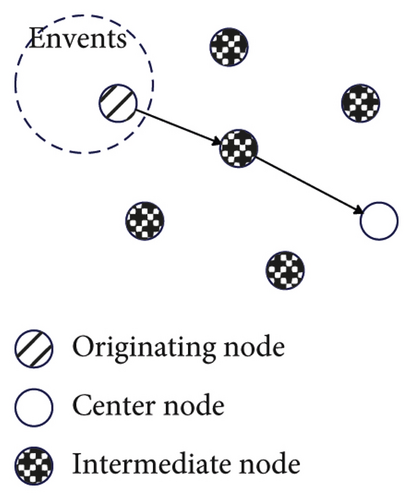
The flow of the LEACH protocol grouping algorithm is shown in Figure 2. After each node has determined the cluster head of the group, it needs to inform the cluster head that it is a member of the group by sending a join request (Joint.REQ) message to the group head. Joint.REQ is a short message that contains the ID of the cluster head node and the sending node.
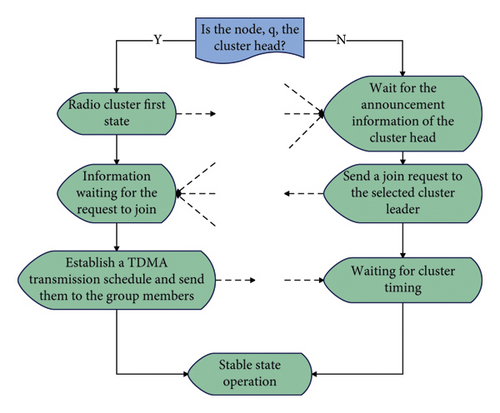
- (1)
In the three-dimensional application space, a large number of sensor nodes are randomly distributed, some nodes are static, and some are moving
- (2)
With the fixed reference point O as the coordinate origin, a virtual three-dimensional coordinate system is established to cover all nodes. The coordinate of any cell J is denoted (XJ, YJ, ZJ), its side length is d (d will be adjusted within a certain range according to the actual situation), the node coordinate is (xi, yi, zi), and the coordinate conversion formula between the cell and the node is shown in formula (1), where int() is the rounding function.
(1) - (3)
The communication radius of the node is r ∈ [0, Rmax], where the maximum communication radius Rmax is the farthest distance between the vertices of two adjacent cells, so the communication is only carried out between adjacent cells. Among them, only neighboring nodes can communicate with each other, and each node stores the geographic location information of itself and neighboring nodes.
- (4)
Cell J contains nJ nodes. When nJ = 0, it is a hollow cell. When nJ > 0, the node that remains active is called the cell parent (equivalent to the leader of the group), and the remaining nJ − 1 nodes that are in a semidormant state are called cell children. The node whose remaining available energy of the i-th node is denoted as Er(i), (i ∈ [0, nJ, −1]), Er(i) > 0 is an effective node. The valid nodes in the cell will participate in the adaptive election of the cell parent, and the election mechanism needs to ensure that each cell has one and only one cell parent.
- (5)
The communication between cells is only completed by the cell parent node, and the cell child nodes can only communicate within the cell, and send the collected information to the cell parent.
- (6)
For the nodes that are just on the boundary of adjacent cells when the cells are divided, these special nodes belong to the multiple cells where they are located, but these cell child nodes cannot participate in the election of the cell parent.
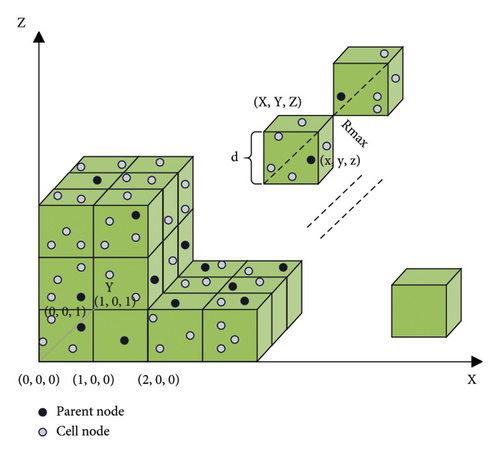
In the 3D cell model, communication is only carried out between adjacent cells, so in order to ensure the smooth routing of the network, smooth communication should be ensured between the parent nodes of adjacent cells. The upper right corner of Figure 3 is a schematic diagram of two adjacent cells in diagonal positions, and in this adjacent manner, the distance between the farthest vertices is Rmax. Therefore, in order to ensure that the nodes on the network can communicate smoothly, the communication capability should cover the farthest distance, and the communication radius should be greater than Rmax.
In general, Rmax is a fixed value, and the values of the communication radius r and the cell side length d can be adjusted according to the actual application conditions within the range that satisfies formulas (3) and (4).
2.2. Data Fusion Model and Energy Consumption Model Based on Mobile Agent
Figure 4 shows a schematic communication diagram of a mobile agent (MA) model. The base station dispatches a mobile agent node to traverse the sensor nodes in the entire network. The (MA) node migrates in the network and collects interesting data information from the sensor nodes according to the command of the base station. At the same time, the collected information is fused to remove redundant components, and finally returned to the base station with the collected and preliminarily processed data information. In this way, the work load of the base station node is greatly reduced.
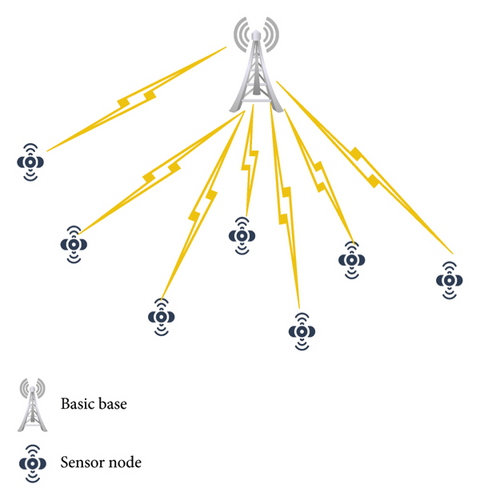
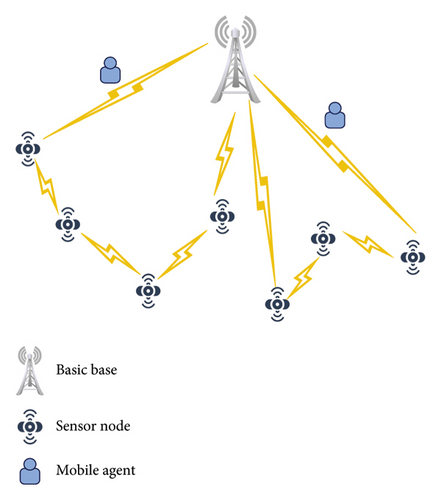
In a single-layer cell system, the cell parent is responsible for collecting, processing, and integrating the cell’s message packets. The base station dispatches the MA to visit the parent, collect and further process the message packet of the parent according to the processing code, store the processed information in the message, and then return through the router. The specific path is shown in Figure 5.
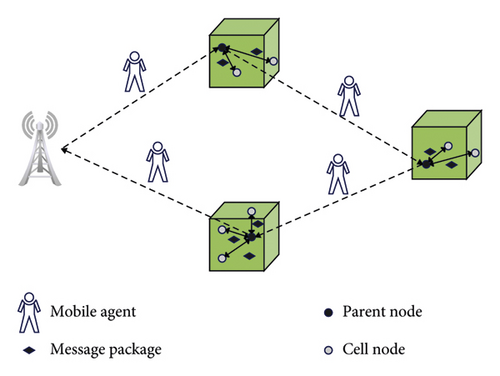
2.3. Data Fusion Technology
The data fusion characteristics of WSNs greatly broaden the network advantages and the research design space of scholars. The content of data fusion technology is very rich, covering digital signal processing and data accumulation technology in the network, as shown in Figure 6.


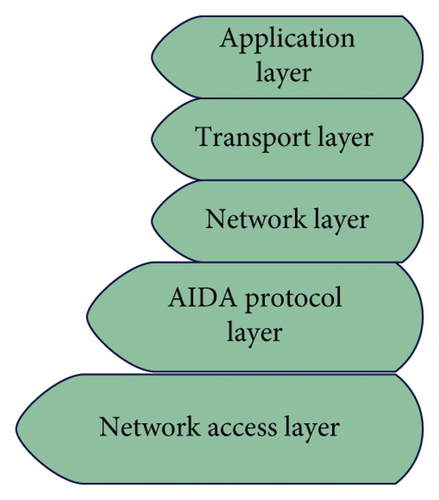
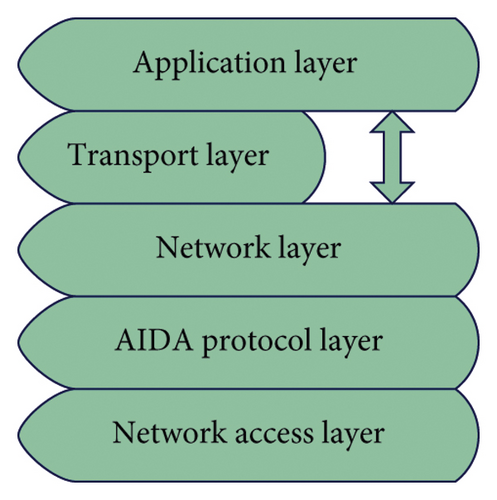
In the final scheme, DYNFA integrates on-demand fusion and fixed fusion, judges its availability by monitoring the queue output by AIDA, and collects the delay data waiting in the queue, as shown in Figure 7.
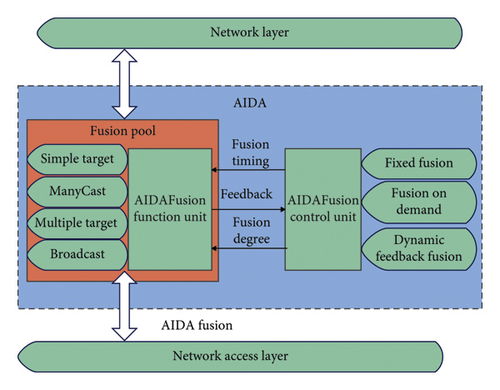
2.4. MA-Based Data Fusion Model
After traversing n nodes, the size of MA (unit: bit) is within the range of , and will increase with the number of nodes.
Among them, lre (unit: bit) represents the size of the data packet carried by the MA after the last fusion, lrd (unit: bit) represents the size of the data collected by the MA at the current node that has not been fused, and Kf represents the energy consumption of the MA to fuse the data volume per unit data size.
The mobile agent code includes the initialization code (unit: bit) and the interesting data information ldata (unit: bit) collected during the migration process. According to formula (10), the code of mobile agent initialization includes header file code and self-processing code. Ideally, it is assumed that the size of the initial code does not change during the entire migration of MA. The data information ldata will gradually increase with the migration of MA.
2.5. MA Parallel Energy-Efficient Routing Algorithm Based on 3D-CSM
It can be seen from formula (15) that if the value of ΔE is less than 0, it means that data fusion is selected to save energy. If the value of ΔE is greater than 0, it means that it is more energy efficient to choose not to perform data fusion. The sign of ΔE depends on the sign of , where Kf and Ktr are constants.
Whether ΔE is positive or negative, it depends only on the value of rAB.
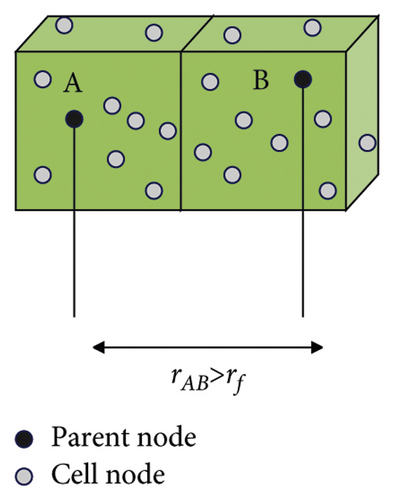
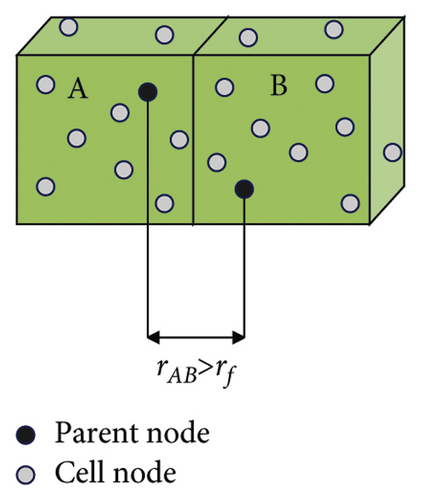
2.6. Single Layer System Model
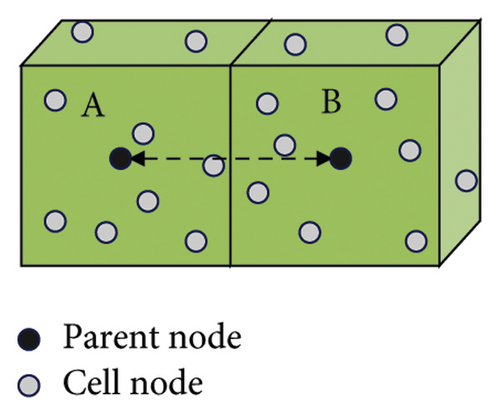
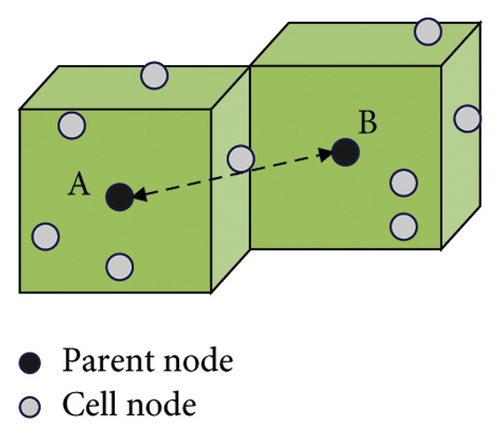
Comparing formulas (17) and (18), when the same amount of data is transmitted, the transmission energy consumption between edge-adjacent cells is twice the transmission energy consumption between face-adjacent cells.
In the two transmission strategies proposed in this paper, the energy consumed by MA traversing all nodes in the layer for data fusion is the same, so only the energy consumption used for data transmission is compared here.

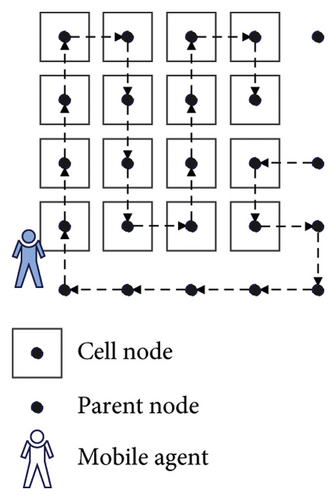
The single-layer system of cells is divided into multiple rings, the base station dispatches one MA to each ring, and the first node visited is in the outermost ring, as shown in Figure 11. In order to avoid repeated visits, the dispatched MA starts to visit nodes only when it reaches the designated layer. For example, in Figure 11(a), the outermost layer is the first ring, and the second outer layer is the second ring. From this inward, the mobile agent A3 is arranged to visit the nodes of the third ring, and cannot collect data information on it while passing through the nodes of the second ring.
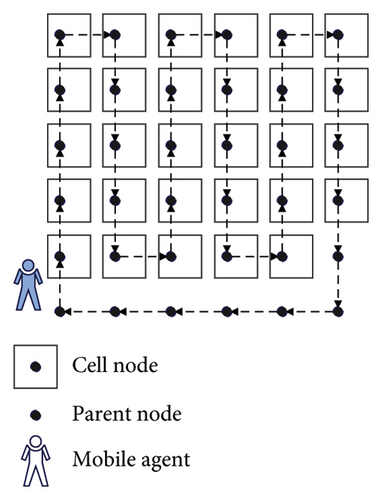
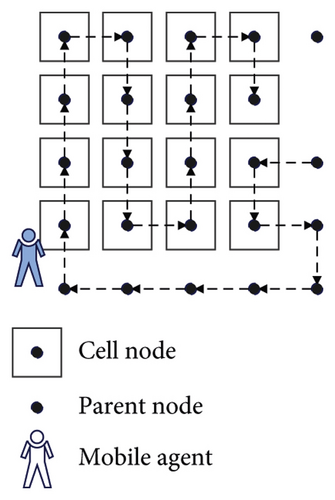
According to the above energy consumption calculation method, the energy consumption of each MA traversed on each ring is added to obtain the total transmission energy consumption of multi-MA traversal.
Based on the 3D-BPMA algorithm, the MA parallel energy efficient routing algorithm (3D-PEMA) based on three-dimensional cell space in this paper adds the data fusion criterion and optimizes the single-layer lateral transmission routing strategy. The flow of its operation is shown in Figure 12.
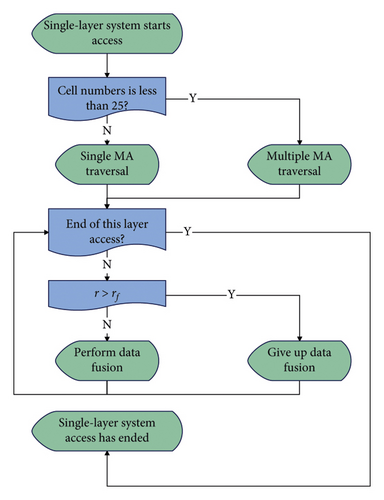
3. Research on the Construction and Realization Path of Cross-Border E-Commerce Logistics Collaboration Model
Combined with the more common e-commerce ecosystem composition method, that is, according to the positioning of species, it is divided into core species, key species, supporting species, and parasitic species. Moreover, this paper attempts to construct a cross-border e-commerce ecosystem structure diagram based on Moore’s business ecosystem structure diagram, as shown in Figure 13.
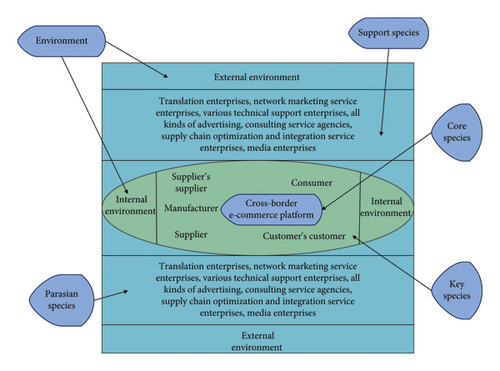
The construction effect of the cross-border e-commerce logistics collaborative model is verified, the collaborative effect of the statistical model is verified, and the practical effect is verified, and the results shown in Tables 1 and 2 are obtained.
| Number | Synergy | Number | Synergy | Number | Synergy |
|---|---|---|---|---|---|
| 1 | 85.60 | 13 | 87.69 | 25 | 80.57 |
| 2 | 84.77 | 14 | 83.50 | 26 | 86.64 |
| 3 | 87.68 | 15 | 87.89 | 27 | 82.44 |
| 4 | 83.25 | 16 | 85.28 | 28 | 85.94 |
| 5 | 87.22 | 17 | 80.65 | 29 | 80.39 |
| 6 | 83.89 | 18 | 82.99 | 30 | 86.23 |
| 7 | 80.54 | 19 | 85.39 | 31 | 85.70 |
| 8 | 82.37 | 20 | 86.48 | 32 | 87.40 |
| 9 | 82.85 | 21 | 81.72 | 33 | 87.61 |
| 10 | 82.18 | 22 | 81.34 | 34 | 84.95 |
| 11 | 81.93 | 23 | 85.68 | 35 | 86.40 |
| 12 | 87.16 | 24 | 83.81 | 36 | 84.42 |
| Number | Practical | Number | Practical | Number | Practical |
|---|---|---|---|---|---|
| 1 | 86.82 | 13 | 85.33 | 25 | 84.47 |
| 2 | 88.35 | 14 | 85.20 | 26 | 87.46 |
| 3 | 85.76 | 15 | 85.85 | 27 | 85.69 |
| 4 | 85.02 | 16 | 85.52 | 28 | 86.36 |
| 5 | 87.08 | 17 | 87.93 | 29 | 84.86 |
| 6 | 87.51 | 18 | 88.96 | 30 | 84.65 |
| 7 | 84.19 | 19 | 87.74 | 31 | 88.29 |
| 8 | 84.72 | 20 | 84.49 | 32 | 87.84 |
| 9 | 85.55 | 21 | 85.14 | 33 | 84.19 |
| 10 | 87.90 | 22 | 85.13 | 34 | 87.18 |
| 11 | 88.04 | 23 | 88.63 | 35 | 86.68 |
| 12 | 88.75 | 24 | 86.22 | 36 | 84.16 |
From the above research, we can see that the cross-border e-commerce logistics collaboration model proposed in this paper has certain effects and can be applied to the actual operation of cross-border e-commerce.
4. Conclusion
The cross-border e-commerce logistics customs clearance mode is a subject that cross-border e-commerce must understand and master. Different cross-border e-commerce logistics customs clearance modes have their own advantages and disadvantages, and different cross-border e-commerce companies have different needs for different logistics customs clearance modes according to their own scale or market positioning. In this way, the discussion of different cross-border e-commerce logistics customs clearance modes, the analysis of the network structure integration of cross-border e-commerce logistics customs clearance, and how cross-border e-commerce logistics service providers and even cross-border e-commerce companies choose their own cross-border logistics distribution and customs clearance modes, have become the core issues of discussion. This paper combines the intelligent logistics communication technology to construct a cross-border e-commerce collaborative logistics model and analyzes its realization process. The data simulation analysis shows that the cross-border e-commerce logistics collaboration model proposed in this paper has certain effects, and it can be applied to the actual operation of cross-border e-commerce.
Conflicts of Interest
The author declare no conflicts of interest.
Acknowledgments
This study was sponsored by Xinxiang Vocational and Technical College.
Open Research
Data Availability
The labeled dataset used to support the findings of this study are available from the corresponding author upon request.




